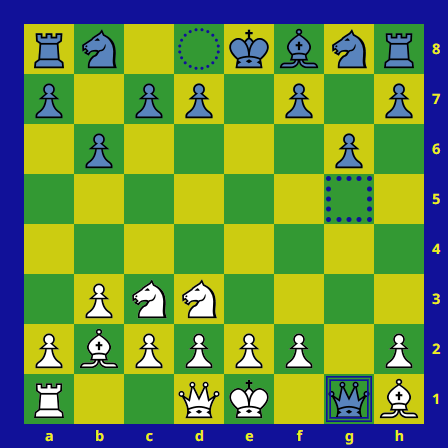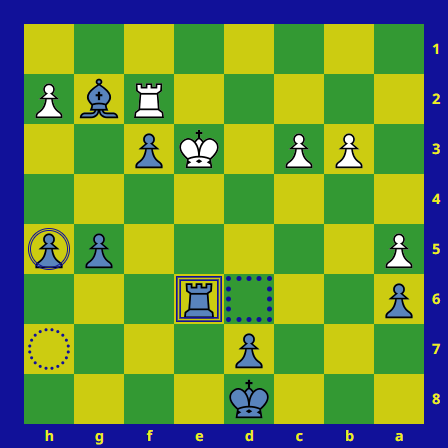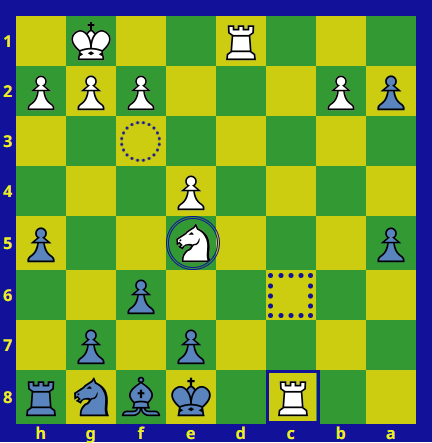Marseillais Chess
This game, which lets each player move twice per turn, was invented by an inhabitant of Marseilles, but it is not known for certain whether this was the journalist Albert Fortis (1871-1926), together with the Norwegian J. Rossow (who lived then in the city), or a somewhat mysterious Jehan de Queylar. The origin of the game dates somewhere between World War I and 1925. It gained a quick following in France. Among the famous chess players said to have played this variant are Alekhine, Reti, Znosko-Borovsky, and Cheron.
Seven decades later, Marseillais Chess was still popular in the now defunct organisations AISE (which produced a large body of games related to the progressive family) and NOST. And it took second place in the second part of the poll for Game Courier Tournament #2 on this site.
Rules
All rules of normal chess apply, but with the following modification. Each turn, a player makes two moves. He may move twice with the same piece, or he may make moves with two different pieces. Castling counts as one move.
If a player gives check on his first move in a turn, he moves only once that turn. A player in check must remove the check in the first half of his turn. A player may never move his King into check, not even on the first half of his turn.
Today's version(s)
A Pawn that was moved two squares in one move (half a turn) could be taken en-passant, even if the Pawn moved in the first half of the turn. The en-passant taking had to be done on the first move of the turn. However, when two Pawns could be taken en-passant, this was allowed.
To reduce White's opening advantage, Robert Bruce suggested in 1963 in Nost-algia the following simple rule change: on his first turn, White only makes a single move. This rule change found wide acceptance (AISE shifted from the classical version to the balanced version in 1990), and usually is preferred above the unbalanced variant (although Fabrice Liardet still organizes Classical Marseillais tournaments in Geneva). The balanced variant has been called Balanced Marseillais Chess, but the `balanced' is increasingly being omitted.
According to Pritchard's Popular Chess Variants, 'The en passant rule has seen change. Modern players allow it only when the Pawn advance formed the second move of a turn.'. This helps to eliminate some ambiguity discussed in the comments. (What if a player advanced a Pawn by two squares, then occupied the intermediate square with a piece?)
The play of the game
Regarding Classical Marseillais, Fabrice Liardet writes that 1. e4/Nf3 or 1. d4/Nf3 are the most popular openings, because 1. e4/d4 allows 1... e5/exd4, and that 1. b3/Bb2 and 1. g4/g5 (the Fortis attack, whose idea is to prevent Black from castling) are interesting alternative first moves.(Alessandro Castelli thinks that 1. e4/Nf3 or 1. d4/Nf3 are theoretical wins for White.)
Regarding Balanced Marseillais, David Pritchard shows in Popular Chess Variants four modern games which all start with 1. d4, but adds that 1. Nf3 and 1. e3 are good first moves for White, unlike 1. Nc3 and 1. e4 which can be met with 1... d5/d4 and 1... d5/dxe4.
Still, the Queen, unlike the King, is very much at risk in this game, so it seems that you are taking chances when you advance the c-Pawn, the e-Pawn and the d-Pawn, with decreasing levels of danger.
The Queen is also weaker. Its value probably doesn't exceed the value of two minor pieces.
Fianchetting the Bishops, or commanding the a2-g8 and h2-b8 diagonals (a7-g1 and h7-b1 for Black) may allow the capture of a few Pawns by igui and/or the exchange of the Bishop for a Rook or a Knight.
In the endgame, a Knight controls more squares than a Bishop.
(See Castelli's comments in his game against Novak.)
Like in Chess, King and Rook (or King and two Bishops) gives mate to a lonely King.
More notably, King and Rook wins also vs. either King and Bishop or King and Knight.
King and Queen against King present some extra risks of stalemate because the losing side has to move twice out of check to avoid that outcome.
(With the position White Ke6, Qc7, Black Kg8, 1. Qb7/Qf7+? 1... Kh8 stalemate)
Examples
The following examples can be viewed move-by-move in Game Courier by clicking on the View button.

Some games do end quickly. David Pritchard gives this miniature by André Chéron in Popular Chess Variants.

Watch also this win by Robert Crépeaux in 1925, which we found on this Orthochess site.
(Indeed, Marseillais Chess seems to be the variant which appeals the most to Orthochess players after Chessgi/Bughouse, and a few Orthochess sites mention the game.)

This famous game opposed Albert Fortis and World Champion Alexander Alekhin, also in 1925. We have kept the comments of David Pritchard in Popular Chess Variants.

At last a modern game. It opposed Alessandro Castelli and P. Novak in 1992. We translated Castelli's comments on Fabio Forzoni's site.

While a game against oneself might not count as a true game, this example does have the advantage of being fully annotated and of ending in checkmate.
Related games
Double Move Chess is a devastating variant which simply does away with the idea of check and mate. Whoever captures his opponent's King wins.
Bennekom Double Move Chess is Marseillais with the same piece moved twice (if legal).
Extra Move Chess - Inspired by Marseillais Chess, this game makes the second move optional and subject to a few restrictions. Unlike Marseillais Chess, which was invented well before Zillions-of-Games was available, this game was designed to be easily programmed for Zillions-of-Games.
Losing Marseillais Chess looks more like a puzzle than a game.
(This page in Italian by Fabio Forzoni shows how 1. e3, 1. e4 and 1. h4 are losing moves for White.)
Computer Play
If you have Zillions of Games, you can download this file by Young-Hyun Joo.
You can play both Marseillais Chess and Balanced Marseillais Chess by online correspondence with Game Courier, a service made available to you through our own site.
Books
- Popular Chess Variants by David Pritchard devotes five pages to Marseillais Chess (there is also an entry for Double-Move Chess).
- Scacchi Marsigliesi by Alessandro Castelli
(see Fabio Forzoni's page)
Written by Hans Bodlaender and Antoine Fourrière, based mainly upon information from the Encyclopedia of Chess Variants and Popular Chess Variants by David Pritchard and various comments by Alessandro Castelli. Some editing by Fergus Duniho.
WWW page created: 1995 or 1996. Last modified: January 02, 2011.
